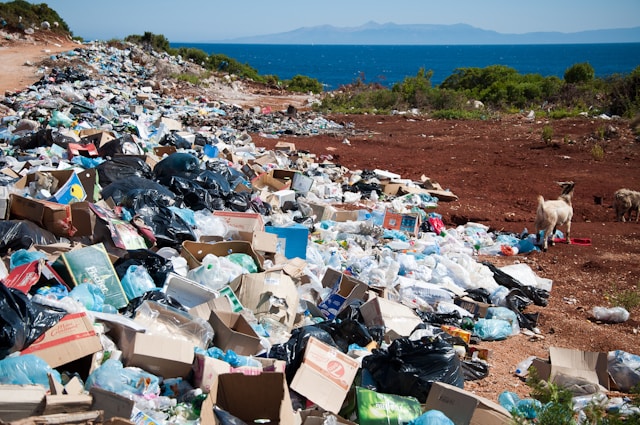The Era of the Anthropocene: A Need for Legal Change
By: Karan Manohar
Defining the Anthropocene
This current period of Earth’s ecological environment is steered by profound human-driven changes that have affected its biological, physical, and geological systems.[1] Consequently, the term Anthropocene was coined to describe this current environmental era, emphasizing how humanity’s growing population and increasing economic activity have fundamentally altered the planet—particularly through climate change, habitat destruction, and biodiversity loss.[2]
The concept of the Anthropocene stands in stark contrast to previous environmental eras, which were primarily driven by natural forces such as glaciation or volcanic activity.[3] Emission of greenhouse gases is an example of how the Anthropocene or human driven activity has contributed towards the degradation of the environment.[4] Greenhouse gas emissions have nearly doubled over the past 40 years, increasing from 27 gigatons of CO₂ per year to 49 gigatons per year, thereby significantly increasing the carbon dioxide levels in the atmosphere.[5] These emissions have disrupted Earth’s climate regulation, leading to rising global temperatures, extreme weather patterns, and shifts in ecosystems.[6]
The mining of phosphorus over recent years has further contributed to accelerated biodiversity loss and habitat destruction, highlighting how the Anthropocene is driving environmental degradation.[7] For example, before the industrial revolution, phosphorus mining was less than 1 million tons annually, a stark contrast to the present-day average of 9 million tons being mined each year.[8] Specifically, these excessive levels of phosphorus have entered into waterways and caused a high level of mortality rates for fish among other animals.[9] High levels of phosphorus have also made areas of the ocean quite literally uninhabitable for most “forms of life” by dissolving oxygen, thereby contributing towards biodiversity loss by eliminating several species.[10]
The third example of human induced activity contributing towards the degradation of the environment can be seen through the prioritization of the pursuit of technical solutions at the expense of the environment, and this becomes problematic because it further exposes “the belief in humankind’s right to exercise total mastery over nature.”[11]
The Current State of Legal Affairs Addressing the Anthropocene
Current legal frameworks remain wholly inadequate to address the ongoing and systemic environmental threat posed by Anthropocene.[12] This is in part because traditional environmental laws were designed to address localized impacts, assuming that environmental harms could be managed within territorial boundaries.[13] However, many environmental issues now require national and international regulation, as the cumulative effects of individual actions contribute to global-scale problems.[14]
This individualized approach towards addressing environmental impacts stemming from the Anthropocene also threatens attempts at creating a unified international law framework, leading to fragmented legal responses that fail to account for the interconnected and transboundary nature of environmental challenges.[15]As a result, international agreements such as the Paris Agreement, while promoting cooperation, remain limited by voluntary commitments and weak enforcement mechanisms.[16] There is also a challenge with attributing legal responsibility for climate-related harms within existing legal doctrines, such as tort law, which requires a direct causal link between an action and harm.[17] This approach is ill-equipped to handle cumulative and widespread environmental damage caused by millions of emitters over time.[18] For example, the framework could result in the problem of diffusion of responsibility, where “because everyone is liable, perhaps no one is.”[19]
Possible Framework For Addressing the Anthropocene
Given these limitations, scholars have called for a transformation in legal thinking, advocating for Earth System Law as a more holistic framework for governing human interactions with the environment.[20] Earth System Law operates on five key principles, which aim to address the scale and complexity of environmental challenges in the Anthropocene.[21] The first principle requires creating ambitious norms that would be reflected in updated legislation to account for the scale and urgency of the Anthropocene’s environmental challenges.[22] Creating updated legislative norms is important because since the 1960s, environmental legislation has consistently “failed to protect the basic structure and integrity of the Earth’s ecosystems.”[23]
The second principle would call for a system of polycentrism, that would create a governance system that would involve collaboration among multiple levels and actors—local, national, and international with an emphasis on a “non-hierarchical approach.”[24] The polycentric “non-hierarchal” model is important because it leads to more deliberation and participation amongst actors to drive environmental reform and change.[25] The third principle is grounded in embracing an epistemology of care that shifts legal analysis from focusing solely on humans to also considering the values of all lifeforms.[26] This inclusive shift in thinking allows for “an expanded view of justice”, which in turn informs better strategies to address the obligations owed to non-humans and individual ecosystems.[27] The fourth principle calls for the acknowledgment that global environmental issues are unpredictable and shifting, which will require flexible and responsive legal approaches.[28] This adaptation model facilitates a seamless adjustment to sudden environmental changes and their impacts.[29] The fifth principle, otherwise known as holistic earth system regulation, calls for a more explicit focus on connecting different legal systems that govern climate change and biodiversity in order to better address global environmental challenges.[30] This form of regulation is important because it allows for the creation of “problem shifting” amongst different countries in assessing environmental impacts as a global phenomenon instead of a localized problem. [31] As the era of the Anthropocene continues to reveal its devastating impact across the global environment, it is imperative that we invest in legal frameworks such as Earth System Law to promote cooperation and accountability in mitigating its effects.[32]
____________________________________________
[1] Eric Biber, Law in the Anthropocene Epoch, Geo. L.J. 106.1 at 3 (November 2017), https://www.law.georgetown.edu/georgetown-law-journal/in-print/volume-106/volume-106-issue-1-november-2017/law-in-the-anthropocene-epoch/.
[2] Olivia Wooley & Cameron Harrington, Law and Governance in the Anthropocene, Glob. Pol’y Inst. at 2 (December 2022), https://onlinelibrary.wiley.com/doi/10.1111/1758-5899.13168?__cf_chl_tk=Q3mOmtRowvBgffwvuPzFAzDm_Rm6ryJPnLqqn16hkec-1740728771-1.0.1.1-J9imm6dp2yUezu_Ad.e5Zmu.p9ZULpjyCshBxJ_M4ng.
[3] Jed Thomas, What Is the Anthropocene and What Does It Mean for Environmental Monitoring?, Env’t Tech. Online (Feb. 2025), https://www.envirotech-online.com/news/environmental-laboratory/7/international-environmental-technology/what-is-the-anthropocene-and-what-does-it-mean-for-environmental-monitoring/64086
[4] Biber, supra note 1, at 9.
[5] Id.
[6] Thomas, supra note 3.
[7] Biber, supra note 1, at 10.
[8] Id.
[9] Id.
[10] Id.
[11] Louise du Toit, Louis J. Kotze, Reimagining international environmental law for the Anthropocene: An earth system law perspective, Earth Sys. Governance Vol. 11 100132 at 3 (Jan. 2022), https://doi.org/10.1016/j.esg.2022.100132.
[12] Biber, supra note 1, at 4.
[13] Id. at 5.
[14] Id.
[15] Toit, Kotzke, supra note 11, at 3.
[16] Id. at 2.
[17] Biber, supra note 1, at 44-45.
[18] Id.
[19] Id. at 45.
[20] Toit, Kotzke, supra note 11, at 4.
[21] Id.
[22] Id. at 5.
[23] Id.
[24] Id.
[25] Id.
[26] Id. at 6.
[27] Id.
[28] Id.
[29] Id.
[30] Id. at 7.
[31] Id.
[32] Id.


